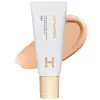Hourglass Cosmetics Veil Hydrating Skin Tint Foundation Versus Chanel Les Beiges Water-Fresh Complexion Touch
What's inside
What's inside
 Key Ingredients
Key Ingredients

 Benefits
Benefits

 Concerns
Concerns

 Ingredients Side-by-side
Ingredients Side-by-side

Water
Skin ConditioningCaprylic/Capric Triglyceride
MaskingGlycerin
HumectantLimnanthes Alba Seed Oil
Skin ConditioningPropanediol
SolventSqualane
EmollientC9-12 Alkane
SolventErythritol
HumectantDicaprylyl Ether
EmollientPolyglyceryl-6 Polyricinoleate
EmulsifyingOctyldodecanol
EmollientDisteardimonium Hectorite
StabilisingDistarch Phosphate
AbsorbentPhenoxyethanol
PreservativePolyglyceryl-2 Isostearate
EmulsifyingMagnesium Sulfate
Zinc Stearate
Cosmetic ColorantSodium Benzoate
MaskingSodium Dehydroacetate
PreservativeButyrospermum Parkii Butter Extract
Skin ConditioningHydrogenated Lecithin
EmulsifyingCoco-Caprylate/Caprate
EmollientBenzoic Acid
MaskingPropylene Carbonate
SolventSodium Hyaluronate
HumectantDehydroacetic Acid
PreservativeLecithin
EmollientEthylhexylglycerin
Skin ConditioningTocopherol
AntioxidantAscorbyl Palmitate
AntioxidantNephelium Lappaceum Peel Extract
Skin ConditioningCitric Acid
BufferingStearic Acid
CleansingCI 77891
Cosmetic ColorantIron Oxides
Water, Caprylic/Capric Triglyceride, Glycerin, Limnanthes Alba Seed Oil, Propanediol, Squalane, C9-12 Alkane, Erythritol, Dicaprylyl Ether, Polyglyceryl-6 Polyricinoleate, Octyldodecanol, Disteardimonium Hectorite, Distarch Phosphate, Phenoxyethanol, Polyglyceryl-2 Isostearate, Magnesium Sulfate, Zinc Stearate, Sodium Benzoate, Sodium Dehydroacetate, Butyrospermum Parkii Butter Extract, Hydrogenated Lecithin, Coco-Caprylate/Caprate, Benzoic Acid, Propylene Carbonate, Sodium Hyaluronate, Dehydroacetic Acid, Lecithin, Ethylhexylglycerin, Tocopherol, Ascorbyl Palmitate, Nephelium Lappaceum Peel Extract, Citric Acid, Stearic Acid, CI 77891, Iron Oxides
Water
Skin ConditioningCaprylic/Capric Triglyceride
MaskingHexyl Laurate
EmollientGlycerin
HumectantButylene Glycol
HumectantDiglycerin
HumectantJasminum Grandiflorum Stem Extract
Castor Oil/Ipdi Copolymer
Amodimethicone
Pentylene Glycol
Skin ConditioningChlorphenesin
AntimicrobialCaprylyl Glycol
EmollientCarbomer
Emulsion StabilisingAluminum Hydroxide
EmollientPolyglycerin-3
HumectantSodium Lauroyl Glutamate
Trisodium Ethylenediamine Disuccinate
Sodium Hyaluronate
HumectantPropanediol
SolventTamarindus Indica Seed Gum
Emulsion StabilisingSodium Hydroxide
BufferingLysine
Skin ConditioningMagnesium Chloride
Alcaligenes Polysaccharides
EmollientGlucose
HumectantCitric Acid
BufferingCI 77007
Cosmetic ColorantCI 77491
Cosmetic ColorantCI 77492
Cosmetic ColorantCI 77499
Cosmetic ColorantCI 77891
Cosmetic ColorantMica
Cosmetic ColorantWater, Caprylic/Capric Triglyceride, Hexyl Laurate, Glycerin, Butylene Glycol, Diglycerin, Jasminum Grandiflorum Stem Extract, Castor Oil/Ipdi Copolymer, Amodimethicone, Pentylene Glycol, Chlorphenesin, Caprylyl Glycol, Carbomer, Aluminum Hydroxide, Polyglycerin-3, Sodium Lauroyl Glutamate, Trisodium Ethylenediamine Disuccinate, Sodium Hyaluronate, Propanediol, Tamarindus Indica Seed Gum, Sodium Hydroxide, Lysine, Magnesium Chloride, Alcaligenes Polysaccharides, Glucose, Citric Acid, CI 77007, CI 77491, CI 77492, CI 77499, CI 77891, Mica
 Reviews
Reviews

Ingredients Explained
These ingredients are found in both products.
Ingredients higher up in an ingredient list are typically present in a larger amount.
This ingredient is an emollient, solvent, and texture enhancer. It is considered a skin-softener by helping the skin prevent moisture loss.
It helps thicken a product's formula and makes it easier to spread by dissolving clumping compounds.
Caprylic Triglyceride is made by combining glycerin with coconut oil, forming a clear liquid.
While there is an assumption Caprylic Triglyceride can clog pores due to it being derived from coconut oil, there is no research supporting this.
Learn more about Caprylic/Capric TriglycerideCi 77891 is a white pigment from Titanium dioxide. It is naturally found in minerals such as rutile and ilmenite.
It's main function is to add a white color to cosmetics. It can also be mixed with other colors to create different shades.
Ci 77891 is commonly found in sunscreens due to its ability to block UV rays.
Learn more about CI 77891Citric Acid is an alpha hydroxy acid (AHA) naturally found in citrus fruits like oranges, lemons, and limes.
Like other AHAs, citric acid can exfoliate skin by breaking down the bonds that hold dead skin cells together. This helps reveal smoother and brighter skin underneath.
However, this exfoliating effect only happens at high concentrations (20%) which can be hard to find in cosmetic products.
Due to this, citric acid is usually included in small amounts as a pH adjuster. This helps keep products slightly more acidic and compatible with skin's natural pH.
In skincare formulas, citric acid can:
While it can provide some skin benefits, research shows lactic acid and glycolic acid are generally more effective and less irritating exfoliants.
Most citric acid used in skincare today is made by fermenting sugars (usually from molasses). This synthetic version is identical to the natural citrus form but easier to stabilize and use in formulations.
Read more about some other popular AHA's here:
Learn more about Citric AcidGlycerin is already naturally found in your skin. It helps moisturize and protect your skin.
A study from 2016 found glycerin to be more effective as a humectant than AHAs and hyaluronic acid.
As a humectant, it helps the skin stay hydrated by pulling moisture to your skin. The low molecular weight of glycerin allows it to pull moisture into the deeper layers of your skin.
Hydrated skin improves your skin barrier; Your skin barrier helps protect against irritants and bacteria.
Glycerin has also been found to have antimicrobial and antiviral properties. Due to these properties, glycerin is often used in wound and burn treatments.
In cosmetics, glycerin is usually derived from plants such as soybean or palm. However, it can also be sourced from animals, such as tallow or animal fat.
This ingredient is organic, colorless, odorless, and non-toxic.
Glycerin is the name for this ingredient in American English. British English uses Glycerol/Glycerine.
Learn more about GlycerinPropanediol is an all-star ingredient. It softens, hydrates, and smooths the skin.
It’s often used to:
Propanediol is not likely to cause sensitivity and considered safe to use. It is derived from corn or petroleum with a clear color and no scent.
Learn more about PropanediolSodium Hyaluronate is hyaluronic acid's salt form. It is commonly derived from the sodium salt of hyaluronic acid.
Like hyaluronic acid, it is great at holding water and acts as a humectant. This makes it a great skin hydrating ingredient.
Sodium Hyaluronate is naturally occurring in our bodies and is mostly found in eye fluid and joints.
These are some other common types of Hyaluronic Acid:
Learn more about Sodium HyaluronateWater. It's the most common cosmetic ingredient of all. You'll usually see it at the top of ingredient lists, meaning that it makes up the largest part of the product.
So why is it so popular? Water most often acts as a solvent - this means that it helps dissolve other ingredients into the formulation.
You'll also recognize water as that liquid we all need to stay alive. If you see this, drink a glass of water. Stay hydrated!
Learn more about Water